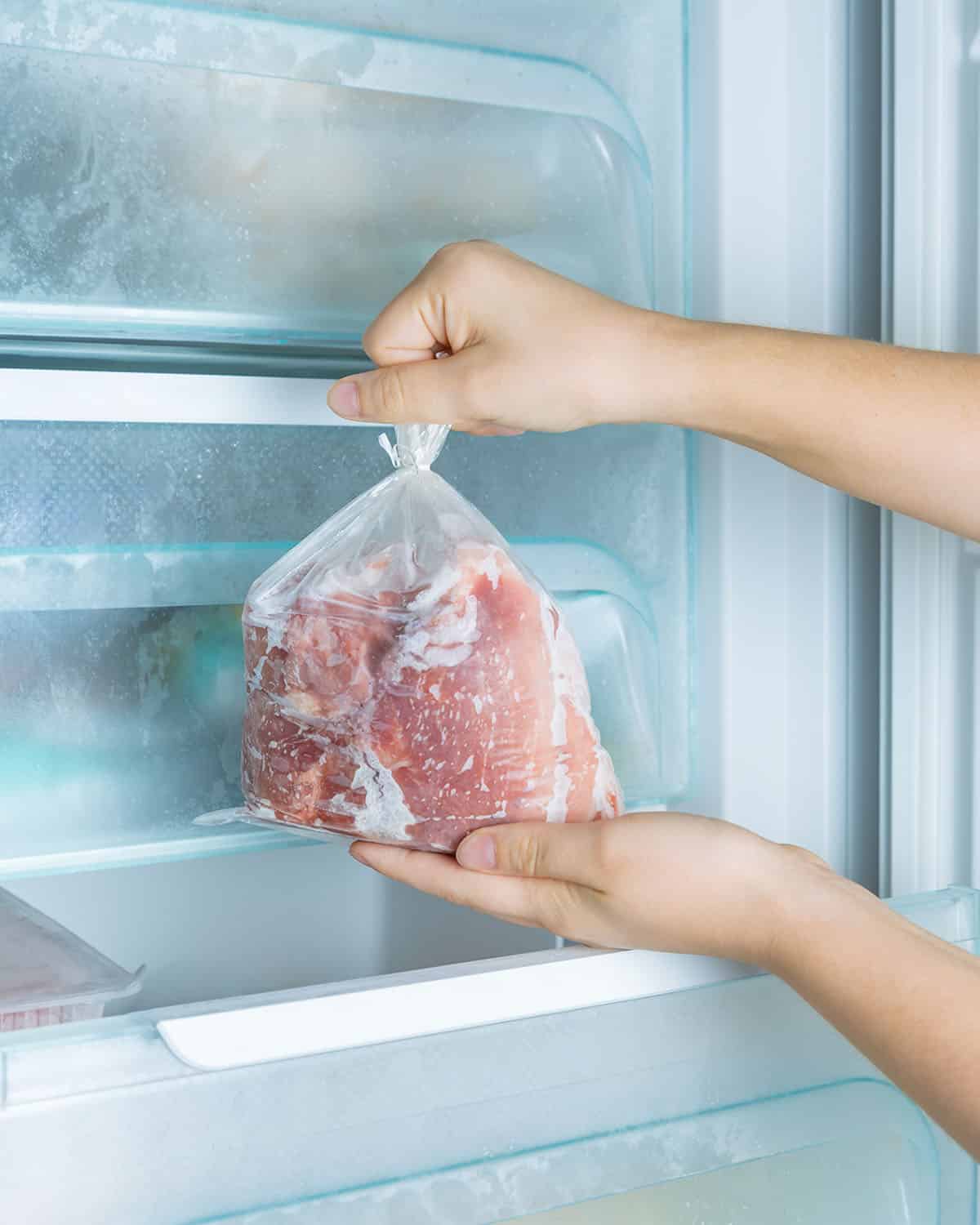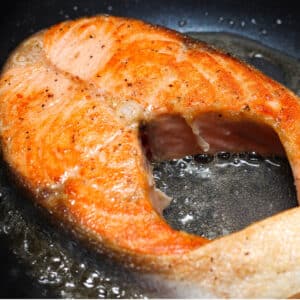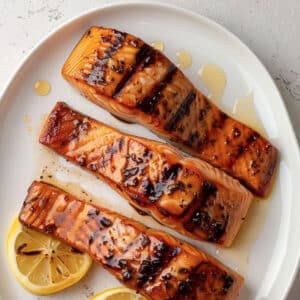Do you ever wonder what those little ice crystals on your meat are? Are they harmless or a harbinger of bacterial doom? In this post, we'll take a look at what these ice crystals mean for your meat and how to keep them from forming in the first place. Read on to learn more!
Jump to:

What do ice crystals in meat signify?
When you see ice crystals in meat, it indicates two things:
1 The water in the meat has started to freeze
2 The temperature of the meat is below freezing.
3 The ice crystals signify that the meat is beginning to spoil.
4 Ice crystals signify that the meat has been frozen and thawed multiple times.
Ice crystals can form on meat for various reasons, but the most common is freezing. When meat is frozen, the water inside the cells expands and forms ice crystals. These ice crystals can puncture the cell walls, causing the water to leak. This is why you'll often see ice crystals on meat that has been frozen for a long period. The longer the meat is frozen, the more ice crystals will form.
- The first point is perfectly normal and nothing to be concerned about. The ice crystals are simply a sign that the meat is cold. In contrast, if there are large ice crystals or the meat appears frozen solid, the meat may have been stored too long and is unsafe for consumption.
- The second point means that the temperature of the meat is below freezing, which means that it is not safe to eat. Why is that? Because when meat freezes, the water inside the cells expands and ruptures the cell walls. This allows bacteria to enter and contaminate the meat.
- The third point is that ice crystals are a sign that the meat is beginning to spoil. This is because as the water in the meat starts to freeze, it also concentrates the sugars and salts.
- The third and fourth points are also undesirable as the meat is spoiled or frozen numerous times. So, if you see ice crystals in meat, it is best to avoid eating it.
The ice crystals in meat indicate the meat's quality.
The smaller the crystals, the higher the quality of the meat. The smaller crystals suggest that the meat contains less water. Less water means more protein and other nutrients per unit of meat weight. Therefore, smaller ice crystals mean that the meat is more nutritious.
Moreover, ice crystals indicate that the meat is old or has been stored in a freezer for too long. If there are a lot of ice crystals on the surface of the meat, it's probably best to avoid eating it. However, the meat is probably still safe to eat if there are just a few ice crystals. If you're unsure, it's always best to err on the side of caution and throw the meat away.
Bottomline, you can use the size of the ice crystals in meat to determine the quality and freshness of the meat. If you see large crystals, it is an indication that the meat is of lower quality and is not as fresh as you would like. On the other hand, if you see small crystals, the meat is of high quality and relatively fresh. Therefore, when choosing meat, look for small ice crystals as an indicator of quality.
Avoid meat with ice crystals for these reasons:
- The presence of ice crystals on meat can indicate an old product.
- Ice crystals can also indicate that the meat has been stored too cold, which can cause freezer burn.
- If ice crystals have formed on the surface of the meat, bacteria may have also begun to grow.
- Finally, ice crystals can make the meat less tender and cause it to lose flavor.
How do food and meat freeze?
Water is present in all foods, and the freezing ability of water makes meat and food freeze. The freezing process of water is a physical change that happens when the water temperature falls below 32 degrees Fahrenheit or 0 degrees Celsius. When water freezes, it forms ice crystals.
Solidification occurs when liquid water in meat or food undergoes chemical changes. As the temperature decreases, the water molecules slowly line up in a specific pattern. Eventually, the water molecules are packed so closely together that they can no longer move about freely, and the water becomes a solid-ice.
The water in food freezes at a lower temperature than the surrounding air. That's why when you leave a glass of water out overnight, it will often have ice crystals floating in it even if the temperature outside is well above freezing.
The same principle applies to meat. When meat is frozen, the water inside it forms ice crystals. These ice crystals can puncture the cells in the meat, causing them to leak, resulting in a loss of moisture and flavor. This is why frozen meat often looks and feels dry when thawed.
Read:
The size of ice crystals as an indicator
It is possible to gauge how long meat has been frozen by the size of ice crystals present in it. In general, smaller ice crystals indicate a shorter freezing period and are thus fresher, whereas large ice crystals show a more extended freezing period and less fresh meat.
So, if you see ice crystals on your frozen meat, it's not necessarily bad. It just means that the water inside the meat has frozen.
However, if the ice crystals are large, it could indicate that the meat has been frozen for a long time and may not be as tender and juicy as you would like. Large ice crystals can cause the texture of the food or meat to change, making it less tender and more difficult to chew.
What is freezer burn?
Freezer burn is the result of moisture loss in food. It occurs when food is stored in a freezer for an extended period, and the air inside the freezer causes the water molecules in the food to evaporate. This results in the formation of ice crystals on the surface of the food.
The ice crystals cause the food to become dry and hard; sometimes, it looks discolored or shriveled. Freezer burn can make the food taste unpleasant and cause it to lose nutrients. When thawing food like this, you'll notice its texture and flavor have changed.
How can I prevent freezer burn?
1 Maintain proper storage
Food placed inside the freezer is usually warmer than the appliance's internal temperature. In the process of cooling, condensation may form ice crystals or frost on the surface. Keep food sealed in freezer-safe containers and moisture-proof wraps as a preventative measure.
Make sure to wrap the food tightly in plastic film or aluminum foil before storing it in the freezer. This will help to keep the moisture inside the food and prevent the formation of ice crystals.
2 Don't leave the door open too long or too often.
Warm air from the outside will enter the appliance through a poorly sealed freezer door. Warm air condenses moisture under cooler conditions and produces frost or ice crystals.
To avoid this, ensure the door isn't left open too long or too often. Ensure that no food or other items are blocking the doors.
3 Inspect the door seals for gaps, cracks, or tears
Make sure there are no gaps between the door seals and the appliance. If you find any, adjust the door seal by gently pulling it away from the door using your fingers.
If your doors aren't sealing right, try cleaning the seal with a soft cloth, sponge, and warm water. Be cautious when cleaning the seals with abrasive products. Loose or cracked seals need to be repaired or replaced. You should contact a service agent if you suspect this may be the case.
4 Use the right packaging.
Another way to prevent freezer burn is to store the food in airtight containers. This will also help to keep the moisture inside the food and prevent the formation of ice crystals. Avoiding freezer burn is also possible by storing food in airtight containers.
5 Set the freezer temperature to -18°C
The ideal freezer temperature is -18 degrees Celsius. Why? Because water freezes at this temperature, and setting your freezer any colder than this means that your ice crystals will be smaller. Smaller ice crystals mean less moisture loss when you defrost your meat.
How does it work? When water freezes, it expands. So, if the ice crystals in your meat are small, there will be less room for them to expand when they thaw, and you will lose therefore less moisture.
6 Use a chest freezer
A chest freezer is a good option for storing food because it keeps the air colder and more consistent. The chest freezer has one big door that opens from the top, rather than a side-by-side fridge/freezer with two doors. When you open the fridge door, warm air from outside rushes in and replaces the cold air. This causes the temperature inside the fridge to fluctuate, which can cause ice crystals to form.
A chest freezer is a more efficient way to store your meat because it can keep it at a lower temperature than your refrigerator. The reason is simple. It has more space and less heat leakage.
How does it work? The key to how a chest freezer works is in its design. The freezer has a larger interior space than a refrigerator and thus can keep food cold for longer. In addition, the chest freezer has thicker insulation which helps to prevent heat from escaping. This means that the food inside the freezer will stay colder for longer.
One thing to keep in mind when using a chest freezer is that you will need to defrost the freezer regularly. This is because the thicker insulation can cause ice to build up inside the freezer. When this happens, it can make it difficult to open the freezer door.
If you do not defrost the freezer regularly, the ice will continue to build up, and eventually, the freezer will become less efficient. When this happens, you may find that your food does not stay as cold as it should.
7 Use a vacuum sealer
Vacuum sealing is another great way to prevent freezer burn. Why is that? Freezing meat in a standard Ziploc bag allows air to remain in the bag. As the meat freezes, this trapped air forms ice crystals on the surface of the meat. These ice crystals not only cause freezer burn but can also make your meat dry and tough.
A vacuum sealer removes the air from a bag or container before sealing it. This prevents freezer burn because the bag has no air to dry out the food. If you don't have a vacuum sealer, you can try using a straw to suck the air out of the bag before sealing it.
8 Limit the amount of time the food is stored
The longer food is stored in the freezer, the more likely it is to develop freezer burn. Why is that? Ice crystals form when water molecules escape from food, and the moisture in the food evaporates, leaving behind dry patches. The longer the food is stored, the more pronounced the dry patches and the more severe the freezer burn.
Therefore, it's best only to store food in the freezer for the time that it will be safe to eat.
9 Use frozen foods within six months
Frozen meat starting to get ice crystals on the surface is still safe to eat, but it won't taste as fresh. The ice crystals signify that the food is beginning to degrade, and the sooner you eat it, the better. Use frozen foods within six months for the best quality. This is especially important for ground meat, poultry, and seafood.
After six months, the quality of frozen foods will begin to decline. The texture of the meat will change, and it will become less tender and juicy. The flavor will also begin to deteriorate.
However, frozen food that has been properly stored can be safe to eat for much longer than six months. If you have any concerns about your frozen meat, poultry, or seafood quality, it's best to err on the side of caution and throw it out.
- For short-term storage of meat and poultry (2 to 3 months), keep it in the coldest part of the freezer, such as the meat compartment.
- For long-term storage (over 3 months), wrap meat and poultry tightly in moisture-vapor-proof paper or plastic wrap and then place them in a resealable freezer bag—store in the freezer section towards the back, where it is coldest.
Remember:
Frost or ice crystals on frozen food can also indicate that the food has been thawed and refrozen. While there is no danger in eating food that has been thawed and refrozen, the quality of the food will suffer. To prevent this from happening, ensure to only thaw frozen food in the refrigerator or microwave, and never at room temperature. Once thawed, cook the food immediately and do not refreeze it.
What happens to meat during freezer burn
As a result of freezer burn, the meat loses its moisture content, which causes it to become dry and tough. The ice crystals that form on the meat's surface result from this moisture loss. When the ice crystals form, they cause the meat to lose its flavor and become less tender. Additionally, the meat may develop a brown or grayish color on the surface.
Why is that? When water molecules evaporate from the surface of the meat, they leave behind dehydrated cells. These dry cells are more susceptible to oxidation, which causes them to turn brown or gray.
Water molecules are in a solid state on the surface of frozen meat. During their natural transition, they transform from a gas to a liquid and finally to a solid. This process is known as sublimation, and it's different from evaporation because the water molecules go directly from a solid to a gas without first passing through the liquid state.
When water molecules sublimate from the surface of frozen meat, they leave behind structurally intact cells. These cells are much less susceptible to oxidation, so frozen meat typically retains its pink color.
So, in short, the appearance of ice crystals on meat indicates that the meat has lost some moisture content and is beginning to dehydrate. This process can cause the meat to become tough, dry, and bland-tasting. The texture of the meat may also change, becoming crumbly or dry. Freezer burn can occur in any meat, including beef, pork, chicken, and fish. It is important to note that freezer burn does not make the meat unsafe to eat, but it can make it less enjoyable.
Why meat gets freezer burn
Two main reasons why meat gets freezer burned are:
- dehydration
- oxidation
Dehydration occurs when meat is exposed to air, causing the water in the meat to evaporate. A loose wrap or improper wrapping can cause this.
Oxidation happens when meat is exposed to oxygen, causing the fats and proteins in the meat to break down. Meat can lose its flavor if it lacks proper sealing or if the sealant is damaged.
Both of these processes can cause the meat to become dry, chewy, and less flavorful. freezer burn does not make meat unsafe to eat, but it can make it less enjoyable.
Why meat gets ice crystals
Main reasons why meat gets ice crystals are:
1 Temperature fluctuations during storage cause the water in the meat to evaporate and condense, resulting in ice crystals forming on the surface of the meat.
How does it work? Water molecules are constantly in motion; when the temperature decreases, they slowly start to form ice crystals. It's the same process that happens when water in a glass begins to condense and form droplets on the outside of the glass.
2 The other reason ice crystals can form in meat is due to freezing and thawing. When meat is frozen, the water inside the cells forms ice crystals. As the meat thaws, the ice crystals melt, releasing the water from the cells. This can result in tough, dry meat.
How does it happen? In the absence of proper packaging, air and moisture can escape, causing the water in the meat to evaporate. This will result in ice crystals forming on the surface of the meat.
3 Ice crystals can also form due to improper packaging, allowing air and moisture to escape, causing the water in the meat to evaporate and condense.
4 Ice crystals in the meat indicate that the product is starting to spoil. If you see ice crystals on your meat, it's best to check the expiration date and throw it away if it's expired.
5 Ice crystals can also form on meat frozen for too long or due to the natural aging process. Water in meat evaporates as it ages, forming ice crystals on the surface. In other words, ice crystals in foods are a natural occurrence and are not necessarily an indication of spoilage.
How to prevent ice crystals from forming
1 Store the meat in the coldest part of the fridge, such as the bottom shelf.
2 Wrap the meat tightly in plastic wrap or aluminum foil to prevent moisture from evaporating.
3 If you're freezing the meat, wrap it tightly in plastic wrap or aluminum foil and then place it in a freezer bag.
4 Use vacuum-sealed bags for long-term storage to prevent freezer burn and keep the meat fresher for longer.
5 Eat the meat within 5-7 days of storing it to prevent ice crystals from forming.
When thawing frozen meat, do so in the fridge overnight or in cold water. Do not thaw meat at room temperature, as this can cause bacteria to grow. Once the meat is thawed, cook it immediately.
Are ice crystals and freezer burn the same?
Yes and no. Ice crystals are normal in frozen food, but freezer burn is not.
Ice crystals form when water molecules in food (or anywhere else) change from liquid to solid states, i.e., freeze. This happens when the water temperature drops below 32 degrees Fahrenheit/0 degrees Celsius. When ice crystals form, they can cause the structure of the food to change, making it dry and crumbly.
Why is that?
The water molecules in food are held together by weak bonds. When the temperature drops and the water molecules turn to ice, the ice crystals that form break these bonds, which can cause the structure of the food to change. This is why foods with a lot of water, like fruits and vegetables, are more likely to be affected by ice crystals than foods with less water, like meat.
Freezer burn, on the other hand, is caused by exposure to air. When food is stored in the freezer, the cold air circulating it causes the surface of the food to dehydrate and form a crust of ice. This can make the food dry and crumbly, and it can also affect the flavor.
The result of dehydration is freezer burn. It happens when food is exposed to air for too long in the freezer. The air removes the moisture from the food, leaving it dry and discolored. Freezer burn does not make food unsafe to eat, but it can make it less flavorful and enjoyable.
So, to sum it up:
Ice crystals are normal; freezer burn is not. If you see ice crystals on your frozen food, don't worry! But if you see signs of freezer burn, you may want to consider throwing the affected food away.




